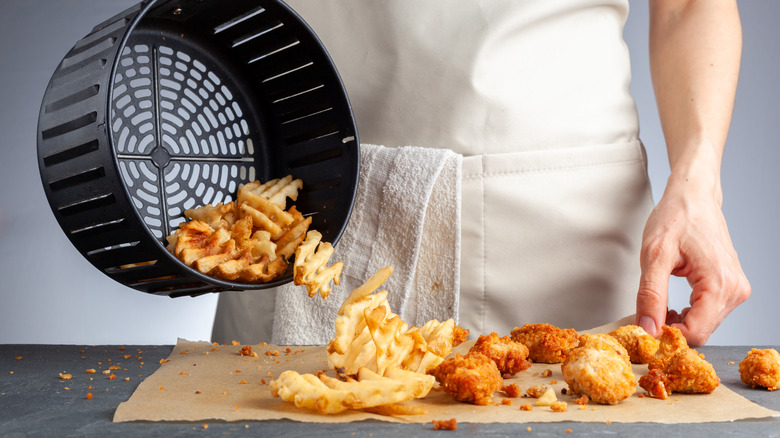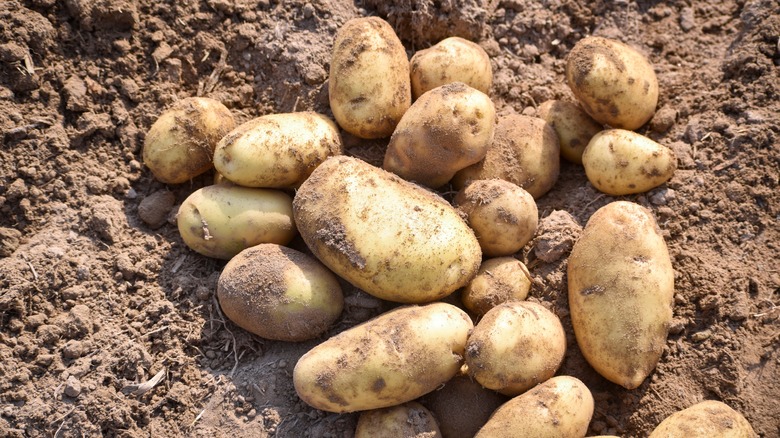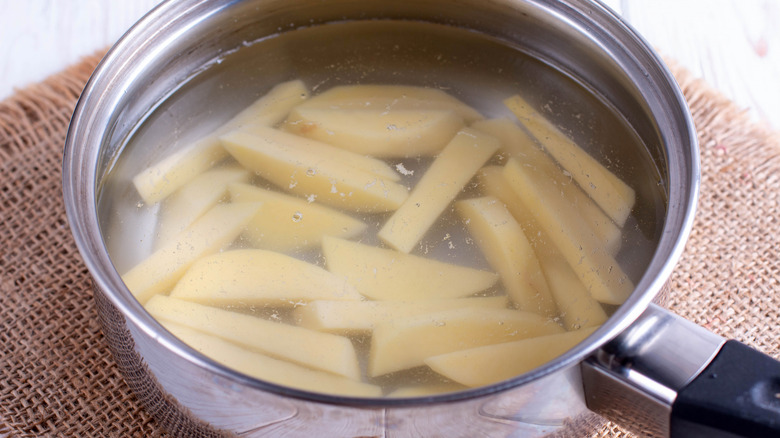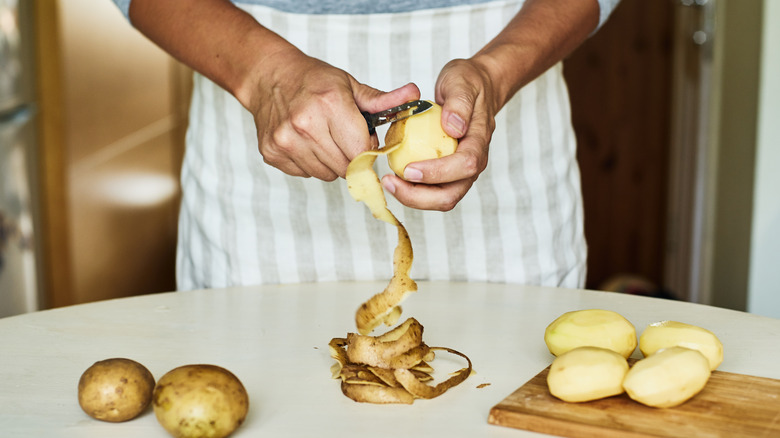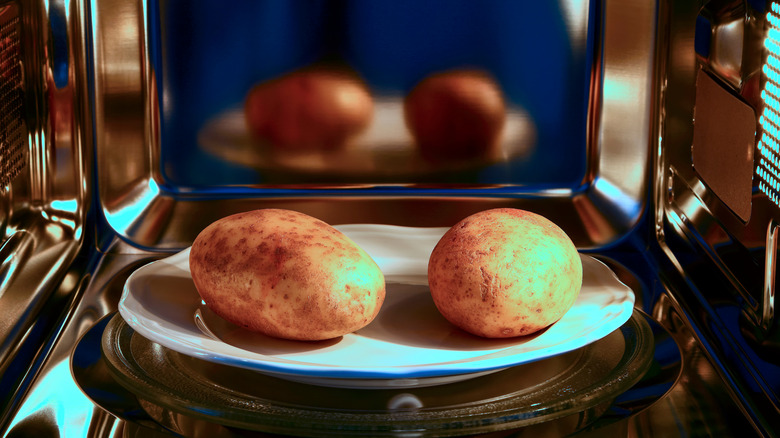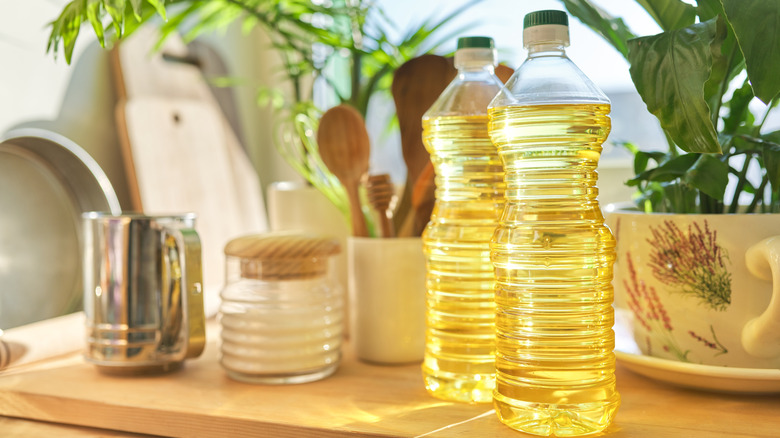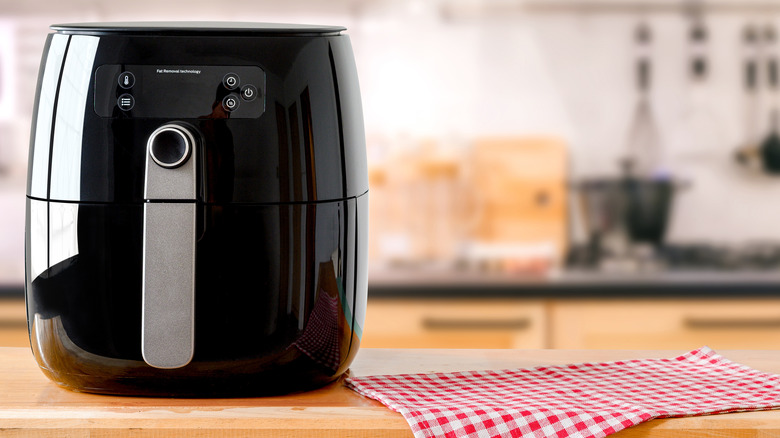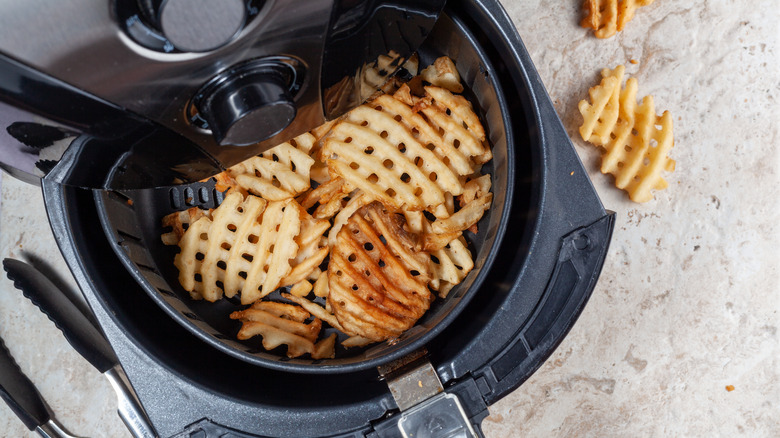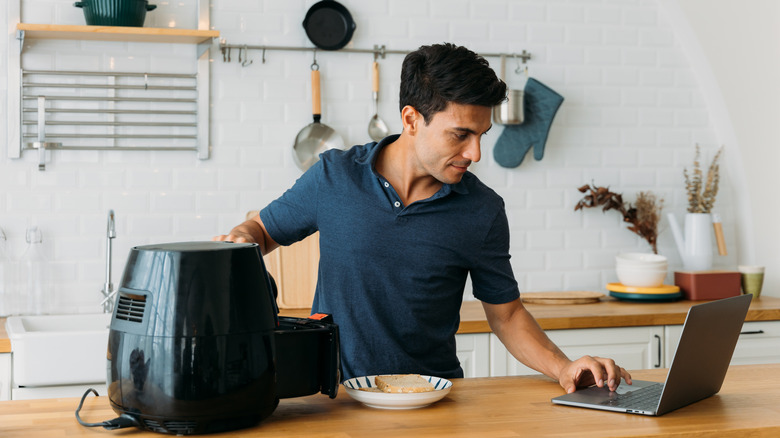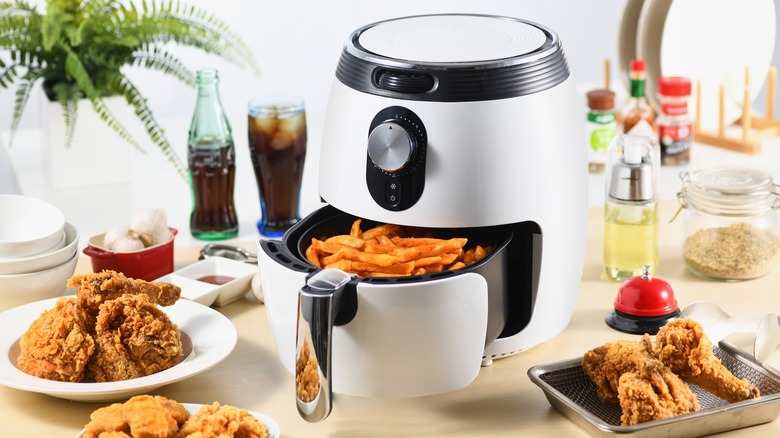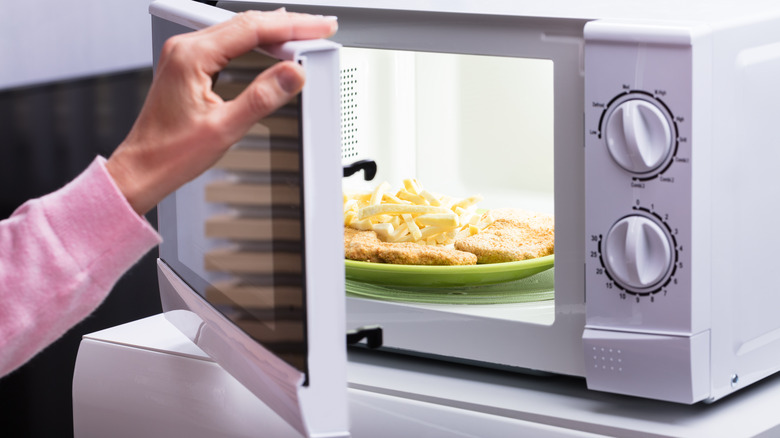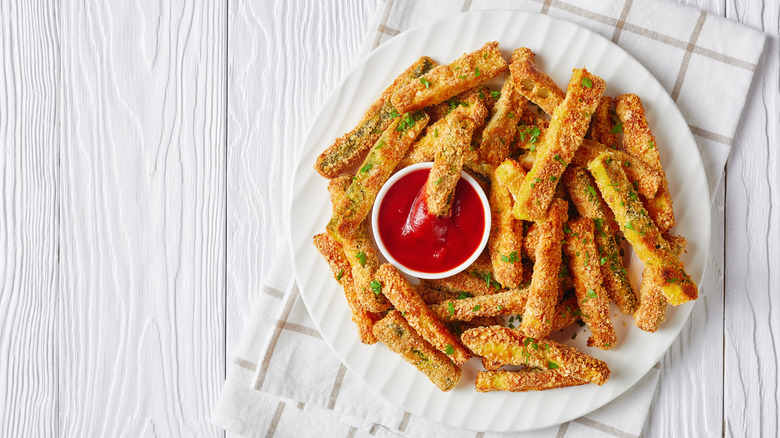Tips For Getting Perfect Air-Fryer Fries Every Time
There are few things as heavenly as the perfect french fry. Crispy on the outside, fluffy and soft on the inside, golden brown and piping hot — no matter where you like to get your fries, from the worst to the best fast food fries, or what you like to dip them in (even though no one can ever agree on what the best dipping sauce is and both topics can cause quite the passionate arguments among foodies), we can all likely agree on a few key factors that make a french fry stand out from its brethren, including internal and external texture, and color.
Achieving that perfect french fry can be difficult all on its own. Deep-frying isn't all that easy at home unless you've invested in a proper deep fryer, and — let's be honest — oven-baked fries are rarely as good as fried. However, when you introduce a brand-new mode of cooking, like air-frying, into the equation, it makes things even more challenging. So how do you crack the code of the perfect air-fryer french fry? Here are a few top tips.
Pick the right potatoes
Perfect french fries start with the right potatoes. Not all potatoes are the same. As this handy graphic from Potatoes USA explains, some potatoes are best for baking, others for mashing, others for grilling, and so on. Which potatoes are best for certain cooking styles depends on factors like a particular potato variety's starch, sugar, and moisture content (via Potato Grower Magazine).
For making fries, Potatoes USA recommends either white potatoes or russet potatoes, which are known for their thick skins and light, airy centers. The Ontario Potato Board seconds this opinion, noting that russet potatoes are high in starch and low in moisture; the high starch content also makes russet potatoes ideal for baking, as the interiors stay fluffy. This same high starch content and fluffiness, however, makes russet potatoes less than ideal for boiling and mashing.
Any Idaho russet potato will work for your fries. According to Idaho Potatoes, popular options include the Russet Norkotah and Russet Burbank varieties. The Kennebec variety was previously very popular and was the french fry potato of choice for In-N-Out, but it's not as popular today.
Soak your fries in water first
If you're accustomed to making frozen french fries, then the process is easy. You just grab the bag from your freezer, rip it open, and pour the contents out on a baking sheet before popping it all in the oven. However, the best, crispiest, most perfect fries start with real potatoes and a lengthier process — a process that can include some serious soaking time.
According to a New York Times article, in which the writer sought out tips from top chefs on making the perfect fry, soaking your potatoes before frying can be the difference between "an excellent french fry and a not-so-excellent french fry." The writer spoke to chef Riad Nasr, who at the time was the executive chef at New York City's SoHo staple Balthazar. Nasr peels his potatoes before soaking them in cold water for eight hours, then cutting them into fry-shape and soaking them for another eight hours. The soaking process, Nasr said, is responsible for the fries' crisp texture; it reduces the potatoes' overall starch content. Later, the writer tried this process for themselves and reported that the lengthy process resulted in fries that were "markedly better" and that "snapped" beneath the teeth and "seemed lighter." If you're having issues with achieving truly crispy air-fryer fries, then it might be time for you to try a potato ice bath.
Cut your potatoes the right way
Whether or not you soak your potatoes, you'll have to cut them somehow, someway. No matter if you go super-skinny, thick, steakhouse-style, shoestring, waffle cut, or with any other option, it's important that all your fries are cut uniformly, as the KitchenAid air-fryer guide notes. KitchenAid recommends that you opt to cook your fries on the skinnier side for faster cooking. The brand particularly suggests potatoes cut about ¼ inch to ⅜ inch thick and 3 to 4 inches long. The brand also recommends cutting and discarding each potato's ends before cutting out your fries.
If you're attempting to cut a very specific style of french fries, Mass Live offers a guide to french fry shapes and how to make them. You may just be surprised at the minute differences between each style. For example, shoestring fries should technically only be ⅓ inch wide, while matchstick fries must be even skinnier.
Pre-cook your potatoes in the microwave
Once you have the perfect potato chosen for your fry-making endeavors, and you've cut and potentially soaked them (if you decide to go that route, however long it may be), then you've pretty much set yourself up for air-fryer success as best you can. However, there's one more potential step you can take to make things even easier. Rather than making your air-fryer do all the work, consider pre-cooking your potatoes in the microwave.
According to Lifehacker, pre-cooking potatoes in the microwave before frying them can help alleviate many issues you may have with the exteriors of your fries cooking before the interior is done. After your potatoes are cut, you just have to throw them into the microwave in a (microwave-safe) bowl and then let the appliance do its thing for a few minutes. The result is a slightly par-prepped potato that is already cooking on the inside to be just perfect by the time you've got it crispy and golden on the outside.
Add your oil the right way
Of course, beyond potatoes, the other ingredient that's a must-have for fries is oil. However, when air-frying, you won't want to choose the same oil you might if you were deep-frying — and you won't want to use it the same way.
As Food Network explains, adding a little oil to your air-fryer is necessary to keep your foods from drying out and help them reach that golden-brown hue you want (especially in a good fry). If you don't have a lot of experience using an air-fryer, it's important to note that you don't add the oil directly to the fryer; instead, you'll want to toss your fries in oil and any seasonings that you might be using, and then add the fries to the fryer basket. Opt for olive oil or vegetable oil, not nonstick spray. While some do recommend using a nonstick spray in your air-fryer, this can actually harm the nonstick coating that's already on your air-fryer basket, so it's best avoided. Lastly, the above guidelines for using oil in your air-fryer only apply to cooking fresh fries. If you're cooking frozen fries, you likely won't need any oil at all.
Preheat your air-fryer
Just like it's you should always preheat your oven for baking success, preheating your air-fryer will ensure you get the crispy french fry results you want, as Purvin Shah, a product development pro at SharkNinja, told Insider. However, preheating your air-fryer isn't as straightforward as preheating your stove, which typically only requires the push of a button or two.
Shah said your best option is to check your air-fryer's manual for any preheating instructions. Typically, preheating an air-fryer only takes a few seconds, and some have a specific preheating setting, while others do not. Some may even automatically preheat without you needing to do anything (your manual should explain this). Regardless, preheating, which brings the fryer's temperature up to a significant degree before you add your food, will nearly guarantee a super-crispy finish. As such, it's often a necessary step when air-frying french fries, both fresh and frozen, or any frozen fried food, such as chicken strips.
Don't overfill the air-fryer
Have you ever baked frozen french fries, pulled out your trusty baking sheet, cut open the bag of fries, poured them out — and then realized that you have way too many fries and way too little baking sheet? If you decided to plow ahead and try baking the fries regardless, you likely ended up with fries that were more sad and soggy than crisp and delicious.
The same thing can happen with your air-fryer. If you put in too many fries and don't take the right precautions, you could end up with a less-than-ideal texture. Food Network says you can stack your fries in a pile but be aware of the air-fryer's maximum fill line. Then, however, you have to shake your fries throughout the cooking process. The shaking is important, as Philips reiterates in explaining how to best use its air-fryers. The manufacturer notes that if you just fill up your air-fryer with your french fries and don't shake them at all, the air-fryer's hot air can't reach all the surfaces of your food, resulting in an uneven cook. The only way to get around the shaking (if you for some reason don't want to do this) is by only putting a single layer of fries in your air-fryer (though this might become annoying, as you could only make a very small quantity of fries at one time).
Adjust your cooking time
If you're still getting accustomed to using your air-fryer, you might assume you can just cook your fries in the air-fryer for the same amount of time that you might cook them in a deep fryer or in the oven. However, you'll want to adjust your typical cooking times for the best results.
According to Taste of Home, fries will take anywhere from 10 to 20 minutes to cook, at 400 F. Thinking that there's a big difference between cooking something for 10 minutes and cooking something for 20 minutes? You're right. As this Mashed 20-minute air-fryer french fry recipe shows, a good place to start is at 380 F with 15 minutes on the timer and check-in and shaking your fryer basket at 7 minutes (at which point you can gauge how fast the fries are browning). If your fries aren't finished at 15 minutes, you can add more time to your cooking process, in increments of a few minutes.
Adjust your method for your second batch
If you're cooking so many fries that you can't fit them all in your air-fryer's basket (remember, you don't want to overcrowd the basket, as that can cause uneven cooking), you may need to cook two or even several batches of fries. You may not think you've overfilled your air-fryer basket. But, if you're having trouble getting a crispy exterior and an even cook throughout your entire batch of fries, you may want to consider lessening your portions and cooking multiple batches to see if you are trying to cook too much at once without realizing it.
However, when you finish your first batch of fries and get ready to cook your second batch, it's important to realize that you may need to adjust your process just slightly. Per America's Test Kitchen, your second batch of fries won't take as long to cook as your first batch, as the air-fryer has increased in temperature over the cooking process. As such, you'll want to check your fries for doneness a few minutes earlier than you might normally.
Make good use of those leftover fries
If you've ever tried to reheat leftover fries in the microwave, then you know true disappointment. No one has ever successfully reheated french fries in the microwave, at least not if they want something beyond soggy, limp, sad fries. Reheating french fries in the oven produces a marginally better outcome. However, your air-fryer is the perfect tool for reheating any leftover fries, not just cooking up a new batch from fresh or frozen.
According to Chef Paul Sidoriak of Grilling Montana (via Insider), reheating leftover french fries in the air-fryer is 25% faster than in your oven. An air-fryer heats quickly enough to properly reheat your fries without drying them out (another problem that comes with reheating fries in the oven). The publication recommends reheating your fries in an air-fryer at 325 F for 5 minutes, checking on your fries, and adding additional cooking time every minute after that.
Go beyond spuds
Once you've successfully conquered the world of cooking french fries in your air-fryer, move on to other veggies. There are quite a few vegetables you can use to create faux fries, including zucchini, yellow squash, avocados, portobello mushrooms, onions, carrots, and butternut squash (via Food Network).
How exactly do you turn a squishy avocado into a crunchy-on-the-outside-soft-on-the-inside snack like a french fry? As this air-fryer avocado fries recipe shows, all it takes is a little breading and dredging, plus 8 minutes in your air-fryer. If you're all out of eggs or don't want to go through the trouble of breading and dredging, you might want to try this super-simple air-fryer carrot fries recipe. If, though, you're looking for something totally unique, you've got to make this jicama fries recipe in your air-fryer, utilizing an often under-appreciated vegetable that's a bit sweeter and crunchier than your average potato. Once you've nailed down your favorite (potato-based) fry recipe, you're just a grocery run away from all sorts of fun air-fried alternatives.
